September, 2016
Lautem, Timor-Leste
After a Sunday of washing our clothes and resting in the nice shade of Lautem’s capital, Lospalos, SESIM trainer Mestra Mimi and I began a week of school visits. We followed teachers from 5 schools into their classrooms to observe and assist them teaching the pratika they had learned from us.
Over the last year, SESIM trainers have visited over 180 of Timor-Leste’s 280 junior high schools, and we’ll visit the rest before next July. Often I don’t get the chance to participate, but every time I do, it increases my perspective on the challenges teachers face.
Visiting a school is like visiting a relative’s home: it becomes quickly obvious whether or not it is a happy place, but you have limited options to help make it happier. Some teachers are glad to see us, others nervous, some complaining from the moment we show up or covering up unsavory parts of their school, others eager to show how they’ve creatively solved some problem. For us SESIM trainers, it is one more chance to put these teachers on the track toward good teaching, and to get feedback on our training.
We showed up each day to a new school during the morning flag raising and singing of the national anthem. It’s a great song, about freedom from exploitation and imperialism.
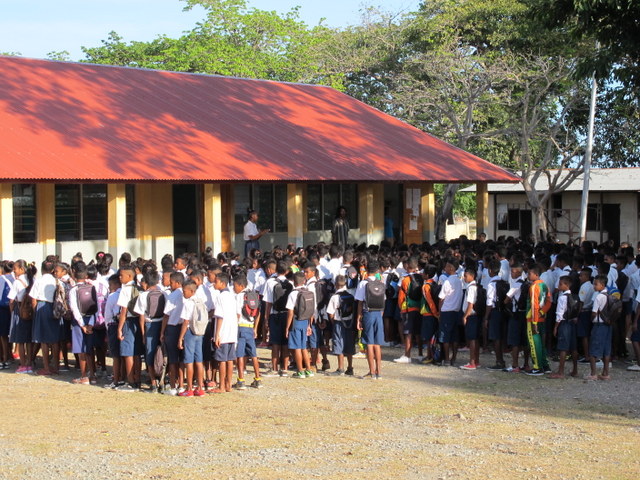
Too many students is a common complaint, and in the capital it’s the rule. But often remote schools don’t have this problem and the difference is enormous. These 23 8th graders in Com were making graphs from everyday shopping situations. Each student needed our help, so we were glad there weren’t any more of them.
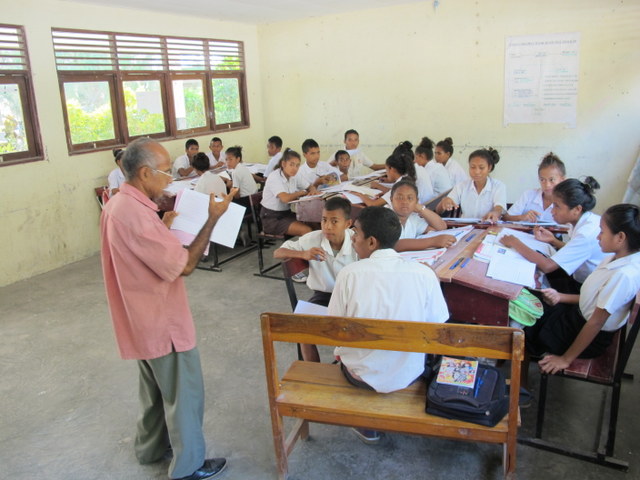
Their teacher wrote this intro on the board before we started, and each student copied it mechanically into their notebooks at a snail’s pace. I estimate that around 30% of class time is wasted copying needless things from the board, yet students assume this is a necessary part of the education process, and uncomplainingly copy whatever the teacher scratches up. Many schools don’t have sufficient books and no school has a copy machine, so there are few options but to copy from the board sometimes. The trick is to limit copying to only necessary information.

Though fairly remote in beautiful mountains, the central school in Luro is overcrowded. New buildings are planned, but meanwhile, they’ve got 140+ students crammed in two 8th grade classrooms.

The teacher did the pratika on surface area and volume of pyramids and prisms with them. We leaked outside for the volume part.

The Lautem town school has plenty of space, but many of the buildings are in disrepair; note the crack in the back wall, ceiling to floor. Sometimes the mathematics and science teachers are the only ones who want students to sit in groups, and have to negotiate with the other teachers or move desks every lesson. This class was not sitting in groups, but the pratika – intersections of lines and planes – was doable in pairs.

Though the school in Com has plenty of classroom space, a couple of the buildings resembled tuna cans. Corrugated sheet metal is a cheap, easy, and durable material for constructing both roofs and walls. It doesn’t do well keeping the classroom cool though.
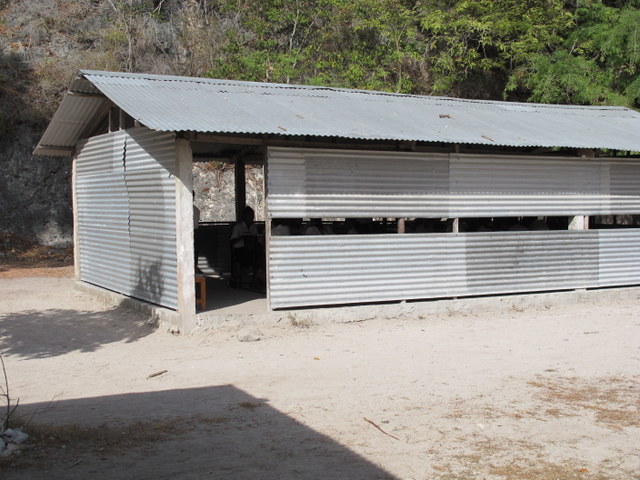
We ran into an all too familiar problem at Odofuro school. The teachers had done the pratika with their students the day before, and they did it again, like a theater production, for us. At the trainings, we tell them very severely not to do this, but the insecure ones do it anyhow, worried I guess that they or their students may look stupid doing it the first time around. It’s not a problem for the students to do it twice, but time is limited, and repeating one pratika means no time for other pratika. Here they are shooting rubber bands at sticks from various distances, and taking data on the success of their shots to graph. Note the military formation.

Odofuro school has a set of computers and a printer, so they printed fancy graph axes and handed one to each group to graph their data. Everyone is watching as the girl with the ponytail draws the bar graph.

Then the spokesperson from each group stood up in front, gave their respect to myself, the teacher, and the school director, and proceeded to read the results of their rubber band shooting. They answered my questions and everyone was happy, but afterward I met with the teacher and pointed out that, #1, doing pratika needn’t be a formal event – it deters from free expression of ideas, #2, when you print the graph axes, the students miss the chance to learn from drawing it themselves, and #3, everyone should have made a graph, because there are various points you learn only by doing it yourself. And I let him know I was not happy to see a reenactment instead of a fresh pratika.

Next day at Laikara school, the same pratika was done entirely differently. Note the freedom of the students, bordering on chaos. The teacher is measuring the shooting distances from the target stick. That’s a mistake; he should have had the students do it.

Back inside after shooting rubber bands from 1, 2, 3, 4, and 5 meters, each student graphed their group’s data. They encountered and resolved all the standard issues of how tall and wide the axes need to be, how many quadrants need to be represented, and what each line in their notebook represents; in other words, excellent learning by every student.

I was pleased to find stuck in this classroom’s wall some evidence that they had already done the line and plane intersection activity.
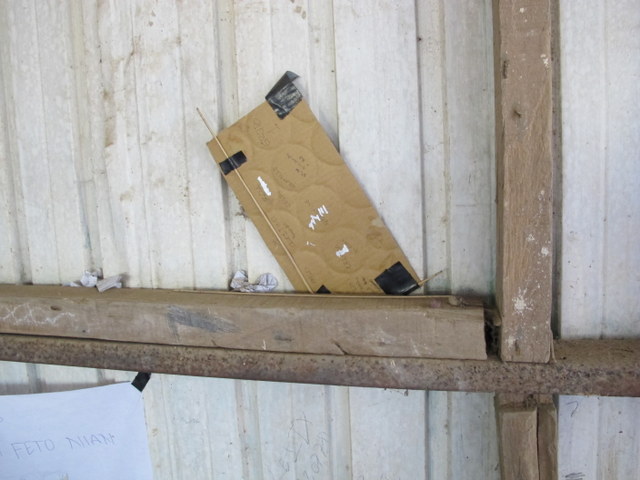
We prefer schools that have morning and afternoon sessions so that we can use our time efficiently, but many times everything is wrapped up by noon and there is nothing left to observe. So this day we found a mountain to climb: Hafa-afa, in Luro. Mestra Mimi and I climbed it with two science teachers and two kids. The mountain’s shadow stretches out behind us to the east.

On the way up the mountain, we found this group of villagers trying to pull a truck up a small slippery rise in the track. We helped them pull, but the loaded truck was quite heavy. The key turned out to be steadily pouring rice hulls under the rear wheels. It took a while, but they made it.

Another night we went fishing with a teacher from Lautem town. Mestre Angelo and his nephew stacked his old holey net into his brightly painted dugout as the sun was setting. The net was around 300 meters long, 3 meters wide, with mesh openings of around 8 cm wide.
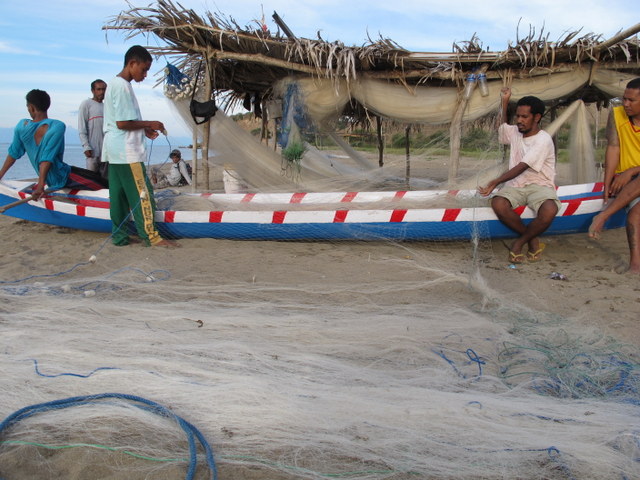
They fastened one end of the net to a stump on the beach and paddled straight out into the sea, letting the net out as they went.
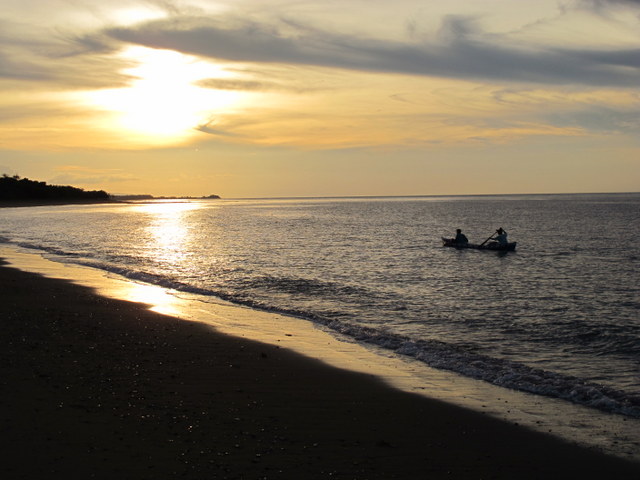
They dropped a rock at the far end to anchor the net. Just as stars came twinkling out they paddled back to shore to sit on the beach and talk about how nice and easy life is while watching the distant bobbing lights from other fishers with more aggressive methods, some of whom will stay out all night in their cramped little outriggers.

After about two hours (less time than usual because I was there with them), they went back out to haul the net in and found several nice fat fish that we took back home and fried up for supper.
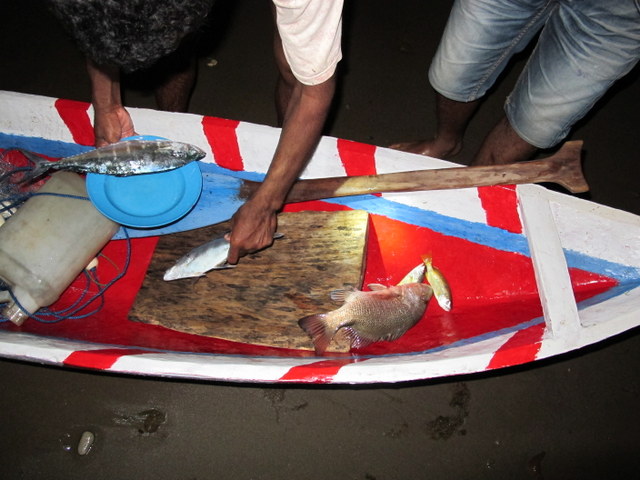
CG

What a great follow up, to be able to go out and observe teachers and classes. The confident teachers would be so pleased to show what they can do.
How close to Lacluta did/will you get with this phase of your work? I cannot imagine practical classes out there. Would love to know they are happenning.
LikeLike